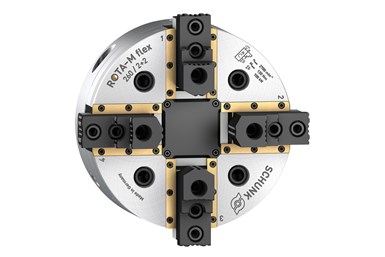Schunk Rota-M Flex Chuck Jaw Offers Flexible Clamping Capabilities
Chuck jaw has a very long compensation stroke, giving it increased flexibility for clampable workpiece geometries and a wide variety of applications.

Sealed guideways ensure process safety of the centrically compensating Schunk Rota-M flex 2+2 chuck.
Schunk’s Rota-M flex 2+2 is a low-maintenance, 2+2 chuck jaw specially designed to maximize clamping flexibility on mill/turn machines. The compensating mechanism provides a very long compensation stroke. Depending on the size, it amounts to 5.1 mm up to 10 mm per jaw. This means a single jaw offers the flexibility to clamp a wide variety of workpiece geometries.
Special seals on the guideways prevent grease from washing out under coolant pressure and gradual loss of clamping force. That company says that, even in the case of low clamping forces, precise functioning of the chuck is ensured. At the same time, the sealings protect the chuck body against chips and dirt, meaning process safety increases and maintenance intervals are extended. For increased safety, the Schunk Rota-M flex 2+2 clamping is done in a self-locking manner, and the clamping condition is signaled via indicating pins. The standard chuck sizes 260 to 1200 achieve jaw strokes from 9.5 to 17.8 mm and high clamping forces from 100 to 180 kN.
With the 800 size, users benefit from the weight-reduced design. The chuck face is equipped with grooves and fixed stops enable the chuck to also be used as a vise. Also, the large sizes are designed for use on vertical lathes. The Schunk Rota-M flex 2+2 is equipped with a flexible serration (1.5 mm × 60 degrees or 1/16" × 90 degrees) so that the user can fully exploit the benefits of a large range of standard chuck jaws.
Related Content
-
The Ins and Outs of Inserts
Understanding how inserts are made provides valuable insight into how their performance can be optimized.
-
The Value of Tool Monitoring on Rotary Transfer Machines
By using a tool monitoring system, shops can save costs associated with machine maintenance and downtime for tool changes while increasing cutting performance.
-
Broaching Tool Technology For Lathes Used to Slot Inconel Parts
This shop finds value in using an indexable-insert-style broaching tool to create blind-hole slots in heat-treated Inconel aerospace parts on a CNC lathe.










.png;maxWidth=300;quality=90)


